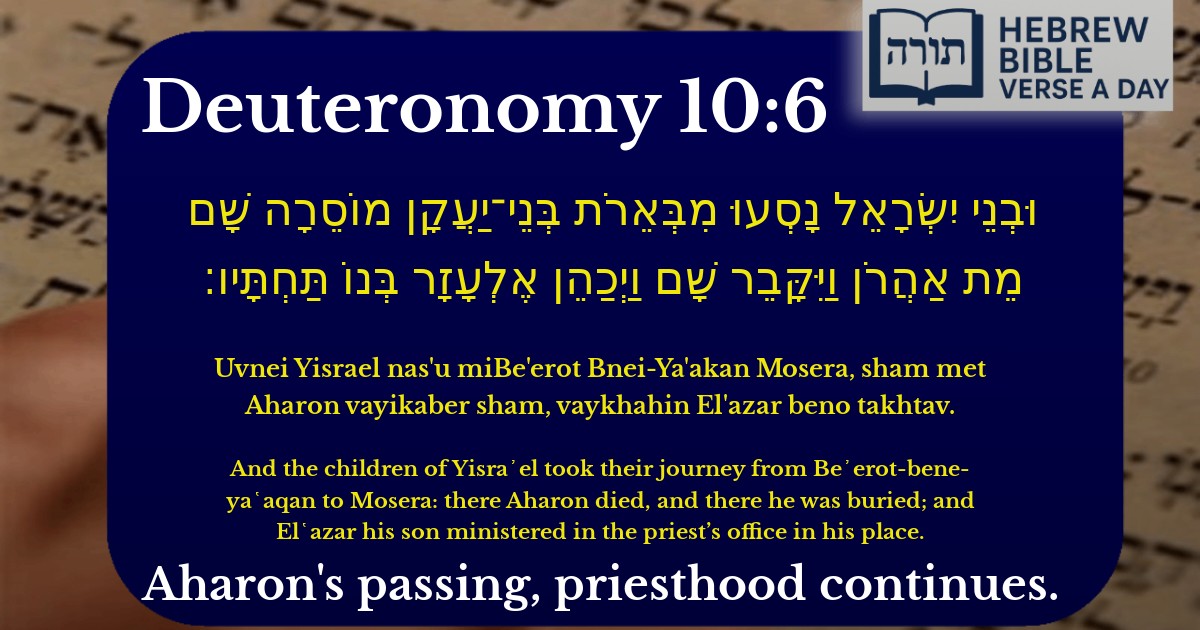Join Our Newsletter To Be Informed When New Videos Are Posted
Join the thousands of fellow Studends who rely on our videos to learn how to read the bible in Hebrew for free!
Hebrew Text
וּבְנֵי יִשְׂרָאֵל נָסְעוּ מִבְּאֵרֹת בְּנֵי־יַעֲקָן מוֹסֵרָה שָׁם מֵת אַהֲרֹן וַיִּקָּבֵר שָׁם וַיְכַהֵן אֶלְעָזָר בְּנוֹ תַּחְתָּיו׃
English Translation
And the children of Yisra᾽el took their journey from Be᾽erot-bene-ya῾aqan to Mosera: there Aharon died, and there he was buried; and El῾azar his son ministered in the priest’s office in his place.
Transliteration
Uvnei Yisrael nas'u miBe'erot Bnei-Ya'akan Mosera, sham met Aharon vayikaber sham, vaykhahin El'azar beno takhtav.
Hebrew Leining Text
וּבְנֵ֣י יִשְׂרָאֵ֗ל נָ֥סְע֛וּ מִבְּאֵרֹ֥ת בְּנֵי־יַעֲקָ֖ן מוֹסֵרָ֑ה שָׁ֣ם מֵ֤ת אַהֲרֹן֙ וַיִּקָּבֵ֣ר שָׁ֔ם וַיְכַהֵ֛ן אֶלְעָזָ֥ר בְּנ֖וֹ תַּחְתָּֽיו׃
Parasha Commentary
📚 Talmud Citations
This verse is quoted in the Talmud.
📖 Zevachim 101b
The verse is referenced in a discussion about the death of Aaron and the succession of his son Eleazar to the priesthood.
📖 Sotah 37a
The verse is cited in a discussion about the locations associated with the Israelites' journey and the events that occurred there, including Aaron's death.


Location of Aharon's Death
The verse states that Aharon died in Mosera, yet in Bamidbar 20:22-29, his death is recorded as occurring at Hor HaHar. Rashi (Devarim 10:6) resolves this apparent contradiction by explaining that Mosera and Hor HaHar refer to the same place. The name "Mosera" (from the root יסר, meaning "chastisement") alludes to the tragedy of Aharon's death, which was a punishment for his involvement in the incident of Mei Meriva (the Waters of Strife, Bamidbar 20).
The Significance of Aharon's Death
Aharon's passing marked a pivotal moment for Bnei Yisrael. The Midrash (Tanchuma, Chukat 10) teaches that Aharon's death was mourned even more profoundly than Moshe's, as Aharon was known for pursuing peace and restoring harmony among people (Pirkei Avot 1:12). His absence left a void in the nation's spiritual leadership.
Elazar's Succession
The verse emphasizes that Elazar immediately assumed the Kehunah (priesthood) after his father's death. Rambam (Hilchot Klei HaMikdash 4:15) derives from here the principle of hereditary priesthood, ensuring continuity in the service of the Mishkan and later the Beit HaMikdash. The Talmud (Zevachim 101b) notes that Elazar's succession was seamless, demonstrating Divine approval.
Be'erot Bene Ya'akan
The journey began from Be'erot Bene Ya'akan ("Wells of the Sons of Ya'akan"), which the Midrash (Bamidbar Rabbah 19:16) connects to the descendants of Ya'akan mentioned in Divrei HaYamim I 1:42. These wells symbolize Torah wisdom (as water represents Torah), suggesting that Bnei Yisrael drew spiritual strength before facing the loss of Aharon.
Lessons from the Verse